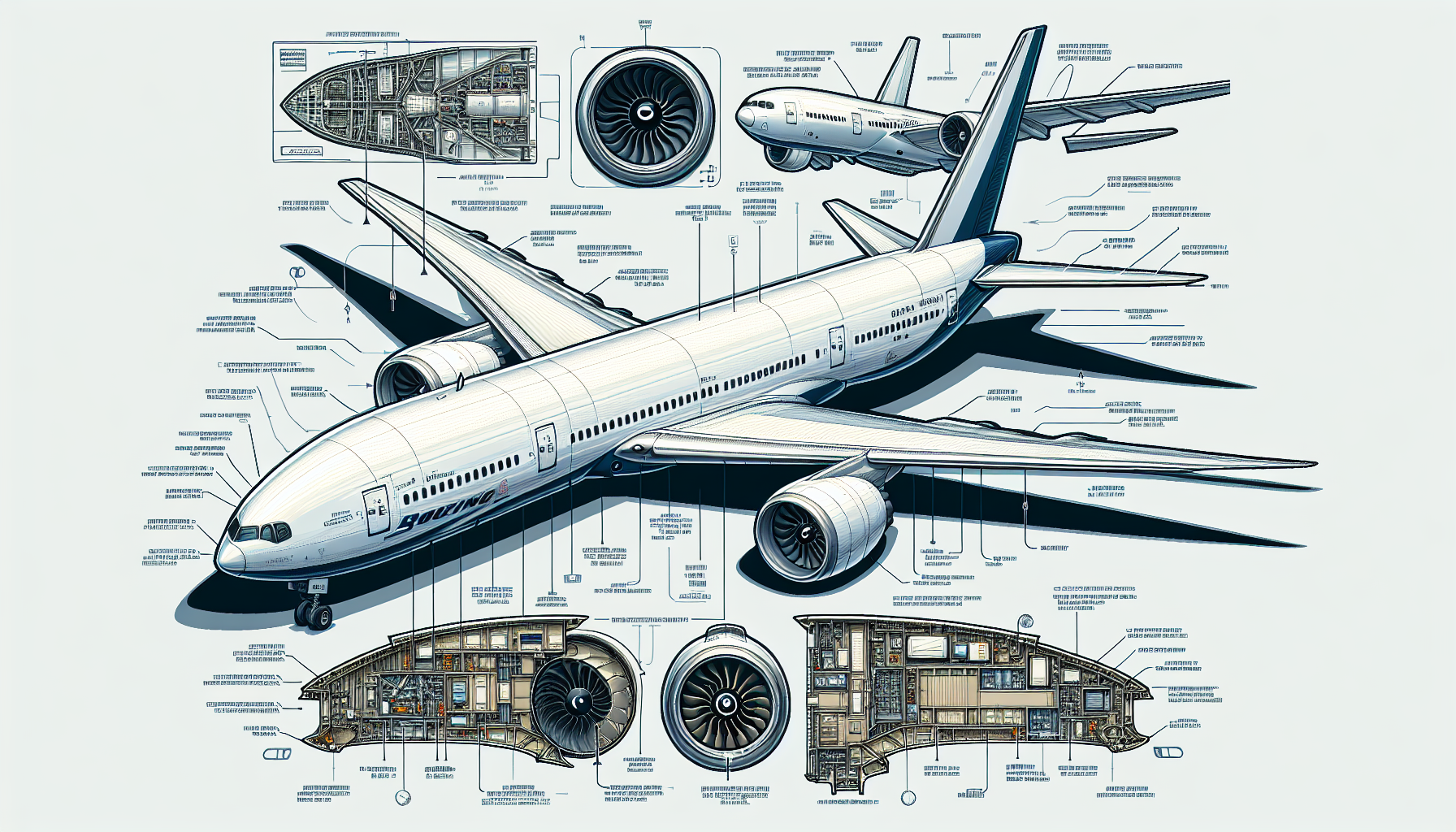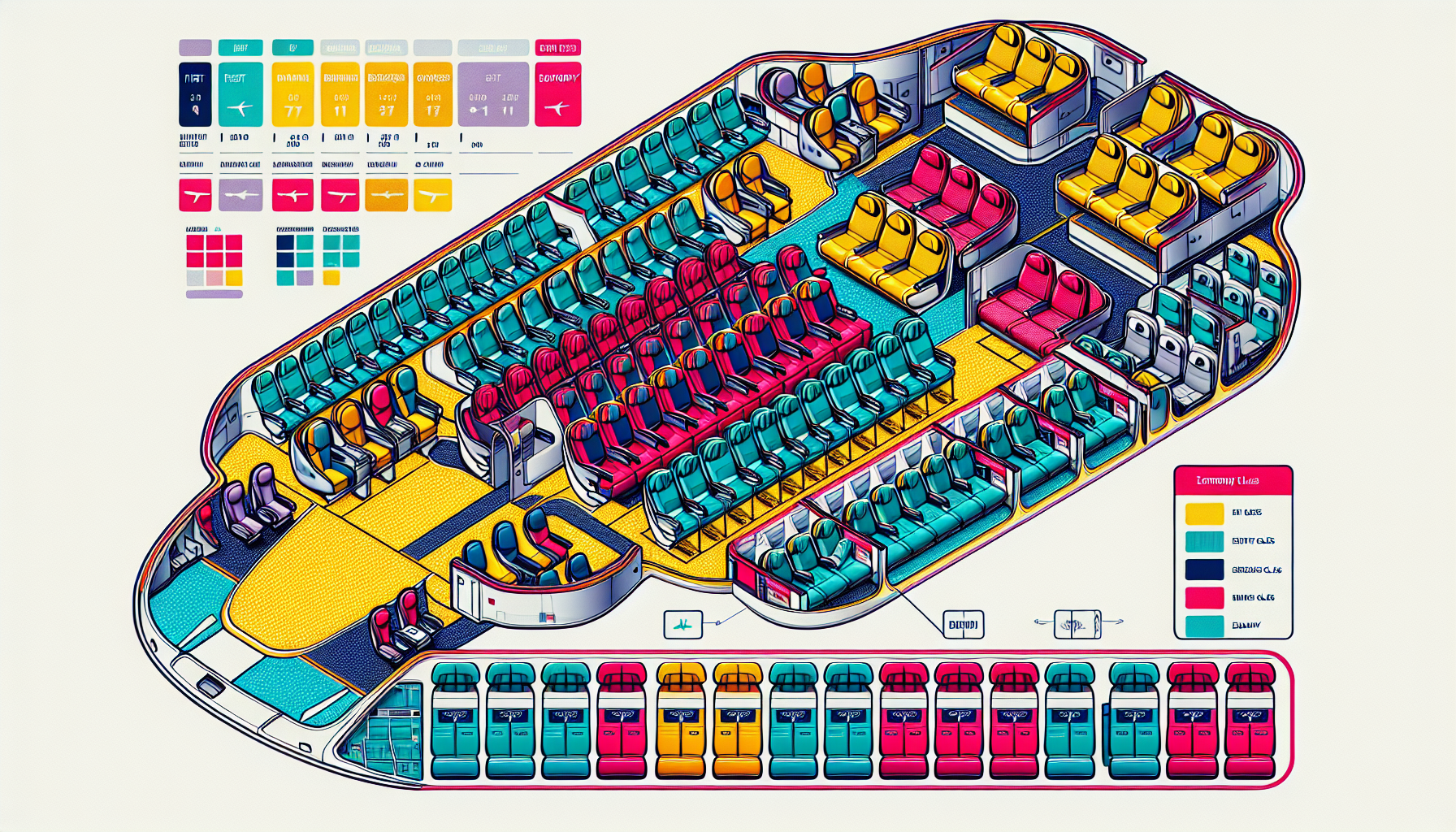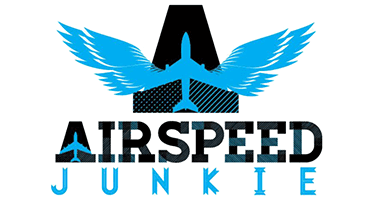Boeing 777: Features, Seat Maps, and Travel Tips
The Boeing 777 is renowned for its long range, large capacity, and fuel efficiency. It’s a favorite for international travel. This article explores its features, seat maps, and travel tips.
Key Takeaways
-
The Boeing 777, a versatile twin-engine aircraft, has been pivotal in long-haul travel and is known for its capacity to efficiently transport both passengers and cargo.
-
The aircraft features advanced materials, engine technology, and a spacious cabin design, contributing to its operational efficiency, fuel economy, and overall passenger comfort.
-
Ongoing innovations, including the introduction of the Boeing 777X series, aim to enhance the aircraft’s performance and sustainability to meet the growing demands of the aviation market.
Overview of Boeing 777

The Boeing 777, often referred to as the ‘Triple Seven,’ is a testament to the ingenuity and innovation of Boeing Commercial Airplanes. Originally introduced to meet the demand for a larger, more efficient twin-engine aircraft, the 777 has since become a cornerstone of long-haul international travel. Its ability to carry both passengers and cargo efficiently has made it a favorite among airlines and passengers alike.
The Boeing 777 has been instrumental in the aviation industry’s recent recovery. With the ongoing growth in passenger and cargo traffic, this aircraft remains a key asset for airlines, aiding them in adapting to the changing commercial aviation landscape.
History and Development
In October 1990, Boeing initiated the 777 program to meet the demand for a more efficient twin-engine aircraft. The goal was to combine the range and capacity of larger jets with the efficiency of a twin-engine design.
The first Boeing 777 entered major assembly on January 4, 1993, a key milestone in its development, which Boeing developed. After rigorous design and testing, it received airworthiness certification on April 19, 1995, and was delivered to United Airlines on May 15, 1995, marking a new era in aviation.
The extended variant, Boeing 777-300, first flew on October 16, 1997, meeting market demands for larger capacity and longer range. On March 13, 2019, the prototype Boeing 777X was introduced, featuring advanced technology and improved fuel efficiency.
Major orders, like Singapore Airlines’ 1995 purchase of 34 777-200ERs and 43 options, highlighted industry confidence in the 777. The 777-9X launch at the 2013 Dubai Air Show, confirmed by Lufthansa’s order of 20 units, further showcased the 777 family’s ongoing success.
Variants and Models
The Boeing 777 family includes several variants tailored to different market needs. The 777-200ER, for instance, is known for its long-range capabilities, making it perfect for international flights. This model allows airlines to operate on extended routes without sacrificing performance.
The Boeing 777-300ER, with its extended fuselage, offers increased passenger capacity and range. This variant is popular among airlines for its ability to carry more passengers while maintaining fuel efficiency and reliability.
The 777X series, the newest addition to the Boeing 777 family, features advanced technology, better fuel efficiency, and new engines. The 777-9 model is particularly anticipated to enhance operational performance, setting new industry standards.
Aircraft Features

Renowned for its impressive features, the Boeing 777 series stands out in commercial aviation. Its advanced aerodynamics and efficient fuel consumption provide exceptional performance and reliability. Innovative materials and systems keep it at the forefront of aviation technology.
One of the key elements contributing to the 777’s success is its versatile design, which allows it to carry both passengers and cargo efficiently. This dual capability means that airlines can maximize their revenue potential on every flight, transporting high cargo loads even when the passenger cabin is full.
Airframe and Materials
The Boeing 777’s airframe uses advanced composite materials that significantly reduce its weight. These materials are lightweight, fatigue-resistant, and corrosion-resistant, leading to lower maintenance costs and increased reliability for airlines.
The 777-9 model features new carbon-fiber composite wings, improving fuel efficiency by 10% compared to similar aircraft, showcasing Boeing’s commitment to sustainability and operational efficiency.
Lightweight materials and strategic structural design enhance the Boeing 777’s operational efficiency. This makes it a favorite among airlines due to its reduced maintenance needs and impressive performance.
Engine Technology
Engine technology is crucial to the Boeing 777’s performance. The aircraft offers the General Electric GE90 and Pratt & Whitney PW4000 engines. The GE90-115B is the most powerful commercial jet engine, boasting record thrust levels that significantly enhance the 777’s efficiency.
The advanced turbofan engines in the Boeing 777 optimize fuel burn, offering airlines better economic performance and reduced environmental impact. These engines reflect Boeing’s commitment to developing powerful and efficient jet engines.
These powerful jet engines enable the Boeing 777 to achieve remarkable fuel efficiency, making it a competitive choice for airlines aiming to minimize operational costs while maximizing performance.
Cabin and Seating
Designed with passenger comfort in mind, the Boeing 777 cabin features high ceilings and spacious storage bins. Modern variations include dynamic LED lighting, creating a pleasant ambiance that adapts to different flight phases.
The interior design prioritizes passenger comfort, earning high ratings from frequent fliers and industry awards. The 777-300ER offers multiple seating configurations, including fully lie-flat beds in premium sections, ensuring comfortable rest on long-haul flights.
American Airlines’ Boeing 777-300ER accommodates 304 passengers across four classes, offering a range of options from luxurious first-class suites to comfortable economy seats. The first-class cabin stands out with spacious seating, high-quality bedding, and personalized service.
Passengers in all classes enjoy personal entertainment systems with individual widescreens, offering a variety of movies, shows, and other options. Combined with the cabin design, these features ensure a pleasant flying experience on the Boeing 777.
Seat Maps and Configurations

The Boeing 777 cabin offers various seat maps and configurations, catering to diverse passenger and airline needs. Typically featuring a three-class layout, it provides a mix of business, premium economy, and economy seating, allowing passengers to choose their preferred level of comfort and service.
In a typical two-class configuration, the Boeing 777 accommodates approximately 392 passengers, with seating arrangements designed for comfort and efficiency. Whether in business class with added privacy and amenities or in budget-friendly economy class, passengers can expect a comfortable journey.
American Airlines Seat Map
American Airlines’ Boeing 777-300ER is designed to maximize passenger comfort and convenience across four classes. The premium cabin has 44 lie-flat seats with a seat pitch of 41 to 42 inches, offering ample space for relaxation and comfortable sleep on long-haul flights.
The Premium Economy section features 28 recliner seats with a seat pitch of 38 inches, providing a significant comfort upgrade over standard economy seats. This section is ideal for passengers seeking enhanced comfort without the full cost of business class, especially those interested in premium economy seats and premium economy seating.
The Boeing 777-300ER economy class has 244 seats with a pitch ranging from 31 to 35 inches, ensuring passenger comfort. The Main Cabin includes 188 standard seats with a pitch ranging from 31 to 32 inches, balancing comfort and affordability for budget-conscious travelers.
Cathay Pacific Seat Map
Cathay Pacific’s Boeing 777 fleet offers various seating options focused on enhanced passenger comfort and convenience. The airline’s seat map caters to different passenger classes, ensuring a pleasant travel experience for all.
In Premium Economy, passengers enjoy wider seats and greater legroom compared to standard economy, enhancing comfort on long flights. Business class seats offer privacy and direct aisle access, ensuring a premium experience for travelers.
Cathay Pacific’s thoughtful seat configurations and emphasis on passenger comfort make their Boeing 777 fleet a preferred choice for many travelers.
Passenger Experience

Flying on the Boeing 777 offers a superior passenger experience across all classes. Its spacious cabin design, with high ceilings and ample storage space, enhances comfort and enjoyment, particularly on long-haul flights.
Attention to detail in cabin layout and amenities ensures a well-rounded travel experience. From personalized service in first class to the thoughtful design of economy seats, the Boeing 777 caters to modern travelers, making every flight memorable.
First Class Cabin
First-class passengers on the Boeing 777 experience unparalleled luxury and comfort. The cabin features private suites with floor-to-ceiling doors, offering high privacy and control over the environment. Personal lighting and temperature settings allow passengers to tailor their space to their preferences.
Personalized dining services further enhance the first-class experience, with à la carte options and midnight snacks prepared by the cabin crew. This bespoke service allows passengers to dine at their convenience, adding exclusivity to their journey.
Entertainment in the first-class cabin includes a personal widescreen television with thousands of channels, providing a private cinema-like experience. This setup makes it easy to pass the time on long flights with a wide selection of movies, shows, and other options.
Business Class
Designed for privacy and comfort, business class on the Boeing 777 offers a premium experience. The seats are typically arranged in a 1-2-1 layout, ensuring direct aisle access for every passenger. This configuration suits business travelers who value convenience and personal space.
A standout feature of business class is the lie-flat seats, which transform into fully flat beds. This feature is especially beneficial on long-haul flights, providing a comfortable sleep that helps travelers arrive well-rested.
Business class passengers enjoy upscale dining options and a selection of premium wines and spirits. Attentive cabin crew service ensures every aspect of the journey meets the high expectations of business travelers in business seats.
Economy Class
Economy class on the Boeing 777 offers a comfortable and affordable option for travelers. The seating configuration generally follows a 3-3-3 layout, which is less dense than some other configurations and contributes to a more spacious feel for passengers.
Passengers in economy class can expect a seat pitch ranging from 31 to 35 inches, depending on the airline and specific aircraft configuration. This provides ample legroom and enhances overall comfort during the flight. Cathay Pacific, for example, offers a seat pitch of 32 to 34 inches in their Boeing 777 economy class, emphasizing passenger comfort.
The seats in economy class seats are designed to provide sufficient legroom and support for long flights, ensuring that even budget-conscious travelers can enjoy a pleasant journey. With thoughtful design and attention to passenger needs, the economy class on the Boeing 777 stands out as a reliable choice for a comfortable flying experience.
Operational Performance
The Boeing 777 is renowned for its operational performance, combining speed, efficiency, and reliability. The aircraft can cruise efficiently at Mach 0.84, providing competitive speed while maintaining excellent fuel efficiency. This balance of performance characteristics has made the 777 a popular choice for airlines operating long-haul international routes.
With a maximum gross weight of approximately 766,000 pounds, the Boeing 777 is capable of carrying substantial payloads, whether in passenger or cargo configurations. This versatility allows airlines to maximize revenue on each flight, making the 777 a crucial asset in their fleets.
Range and Payload
The Boeing 777 is celebrated for its impressive range and payload capabilities. The long-range variant, the 777-200LR Worldliner, can achieve a range of about 13,000 nautical miles, making it capable of connecting virtually any two cities in the world without needing a stop. This extended range is particularly valuable for airlines operating ultra-long-haul flights.
In terms of payload, the Boeing 777-300ER is notable for its ability to carry a maximum payload of 224,000 pounds (101.6 tons). This capacity allows airlines to transport significant amounts of cargo alongside passengers, enhancing the aircraft’s overall operational efficiency.
The combination of long-range capabilities and substantial payload capacity makes the Boeing 777 a versatile and invaluable tool for airlines, enabling them to operate efficiently across a wide range of routes and market conditions.
Fuel Efficiency
Fuel efficiency is a key strength of the Boeing 777, driven by advancements in engine technology and aerodynamic design. The aircraft’s engines, including the General Electric GE90, Pratt & Whitney PW4000, and Rolls-Royce Trent 800, are designed to optimize fuel burn, resulting in significant cost savings for airlines.
The specific range of the Boeing 777, which is around 30 nautical miles per 1,000 pounds of fuel, highlights its efficiency. This high fuel efficiency not only reduces operational costs but also minimizes the environmental impact of flights, aligning with the industry’s growing focus on sustainability.
Future upgrades to the Boeing 777 are expected to further enhance its fuel efficiency. These enhancements will likely include the integration of the latest aerodynamic improvements and advanced materials, ensuring that the 777 remains a competitive and eco-friendly choice for airlines.
Cargo Capacity
The Boeing 777 is not only a passenger aircraft but also a formidable cargo carrier. The dedicated freighter version, the Boeing 777F, has a maximum payload capacity of around 229,000 pounds, making it one of the most capable cargo aircraft in the world. This high payload capacity allows airlines to transport significant volumes of goods efficiently.
The 777-300ER model also offers impressive cargo capacity, with a maximum cargo volume of 201.6 cubic meters (7,120 cubic feet). This versatility means that the aircraft can be used effectively for both passenger and cargo operations, providing airlines with greater flexibility in their fleet management.
The Boeing 777F is specifically designed for cargo operations, ensuring that it meets the demands of global logistics and supply chains. With its robust design and high payload capacity, the 777F is a critical asset for airlines and freight carriers worldwide.
Safety and Incidents
Safety is a paramount consideration in the design and operation of the Boeing 777. While the aircraft has experienced a total of 31 reported incidents, with five resulting in hull losses, these events highlight the importance of continuous improvement in aviation safety.
Despite these incidents, the Boeing 777 remains one of the safest aircraft in the skies, thanks to its numerous safety features and robust design. The incidents have led to valuable lessons and advancements in safety protocols, ensuring that the 777 continues to uphold the highest safety standards in the industry.
Safety Features
The Boeing 777 is equipped with a range of safety features designed to enhance its operational safety. One notable feature is the noise-reducing technology integrated into the aircraft’s engines, which not only complies with strict environmental regulations but also minimizes noise pollution.
Additionally, the aircraft is designed with numerous safety enhancements, such as advanced navigation systems and robust structural components. These features contribute to the 777’s reputation as a reliable and safe aircraft, providing peace of mind for passengers and crew alike.
Notable Incidents
The Boeing 777 has been involved in several notable incidents, which have resulted in a total of 542 fatalities. The first fatal incident occurred on September 5, 2001, marking a somber moment in the aircraft’s history.
One significant incident involved a United Airlines Boeing 777 that had to make an emergency landing due to a tire failure shortly after takeoff. This event underscored the importance of rigorous maintenance and safety checks to prevent such occurrences.
Another notable incident involved a crash landing due to engine failure, highlighting the critical role of engine reliability and the need for continuous improvements in engine technology. Despite these incidents, the Boeing 777’s overall safety record remains strong, with valuable lessons learned from each event.
Orders and Deliveries
The Boeing 777 has seen significant demand since its introduction, with total orders reaching 2,279 as of June 2024. Of these, 1,734 aircraft have been delivered to various airlines around the world, underscoring the 777’s popularity and reliability in the aviation industry.
Major customers for the Boeing 777 include Emirates, which has ordered 345 aircraft, Qatar Airways with 159 orders, and Singapore Airlines with 116 orders. These figures highlight the trust and confidence that major airlines place in the Boeing 777, making it a cornerstone of their fleets.
Major Operators
Emirates is the largest operator of the Boeing 777, with a fleet of 148 aircraft as of November 2023. This extensive fleet allows Emirates to operate a vast network of routes, connecting major cities across the globe with efficiency and reliability.
Other significant operators of the Boeing 777 include United Airlines with 96 aircraft and Qatar Airways with 81. These airlines leverage the 777’s capabilities to offer a range of international flights, providing passengers with a consistent and comfortable travel experience.
Delivery Milestones
One of the most notable delivery milestones for the Boeing 777 was the unveiling of the 1,000th aircraft, a 777-300ER model, at a factory ceremony in March 2012. This milestone marked a significant achievement for Boeing and underscored the 777’s success in the market.
Major customers who have received the most Boeing 777 aircraft include Emirates, Singapore Airlines, United Airlines, ILFC, and American Airlines. These airlines have played a pivotal role in the 777’s success, with their substantial orders and deliveries highlighting the aircraft’s importance in global aviation.
Future of the Boeing 777

As the aviation industry continues to evolve, the Boeing 777 is expected to undergo significant advancements to meet the demands of increased air traffic and the need for more efficient travel solutions. The future of the 777 looks promising, with ongoing innovations aimed at enhancing its performance and sustainability.
The introduction of the Boeing 777X series, particularly the 777-9 model, is set to revolutionize the aircraft’s operational capabilities. Featuring improved fuel efficiency and advanced technology, the 777X is poised to set new benchmarks in the aviation industry, ensuring that the Boeing 777 remains a competitive and relevant choice for airlines.
Upcoming Upgrades
Future upgrades for the Boeing 777 are likely to focus on enhancing efficiency within airline operations. Technological advancements will play a crucial role in these improvements, with a particular emphasis on fuel efficiency and operational performance.
These upgrades aim to position the Boeing 777 competitively in the evolving aviation market. By integrating the latest aerodynamics and materials, Boeing ensures that the 777 continues to meet the high standards of modern air travel.
Market Outlook
The future aviation market indicates a strong demand for larger aircraft like the Boeing 777, driven by increased passenger and cargo traffic. This trend is particularly evident in emerging markets, where air traffic growth is expected to be robust.
For instance, in Africa, air traffic is projected to grow by over 7% annually through 2042, highlighting the need for efficient and capable aircraft like the Boeing 777. This demand underscores the 777’s crucial role in the future of aviation, ensuring its continued relevance and success.
Summary
The Boeing 777 has established itself as a cornerstone of modern aviation, renowned for its efficiency, versatility, and passenger comfort. From its inception in the early 1990s to its current iterations, the 777 has continually evolved to meet the demands of the aviation industry,,,.
The aircraft’s advanced features, such as its powerful jet engines, innovative airframe materials, and thoughtfully designed cabin, have set high standards in commercial aviation. Moreover, its strong safety record and capacity for both passenger and cargo operations make it a valuable asset for airlines worldwide,,,.
Looking ahead, the future of the Boeing 777 appears bright, with ongoing technological advancements and a strong market outlook. As airlines continue to seek efficient and reliable aircraft to meet growing travel demands, the Boeing 777 is well-positioned to remain a leader in the skies. Whether you’re a frequent flyer or an aviation enthusiast, the Boeing 777 represents the pinnacle of modern air travel, embodying the innovation and excellence that define the aviation industry,,.
Frequently Asked Questions
What makes the Boeing 777 stand out in commercial aviation?
The Boeing 777 stands out in commercial aviation due to its efficiency, versatility, and passenger comfort, bolstered by its advanced aerodynamic design and powerful jet engines. This combination results in superior performance and reliability, making it a preferred choice among airlines worldwide.
How many variants of the Boeing 777 are there?
The Boeing 777 family comprises multiple variants, including the 777-200LR, 777-300ER, and the newer 777X series, each designed to meet distinct market needs.
What are the seating configurations like on the Boeing 777?
The Boeing 777 commonly offers a three-class seating configuration, including business, premium economy, and economy classes. While specific seat maps may differ by airline, the design prioritizes passenger comfort in all classes.
How has the Boeing 777 performed in terms of safety?
The Boeing 777 exhibits a strong safety record, bolstered by advanced safety features and ongoing enhancements in safety protocols. This positions it as one of the safest aircraft in operation today.
What does the future hold for the Boeing 777?
The future of the Boeing 777 is promising, particularly with the introduction of the 777X series that offers enhanced fuel efficiency and advanced technology. This evolution will ensure that the 777 remains a competitive option for airlines in the changing landscape of aviation.







